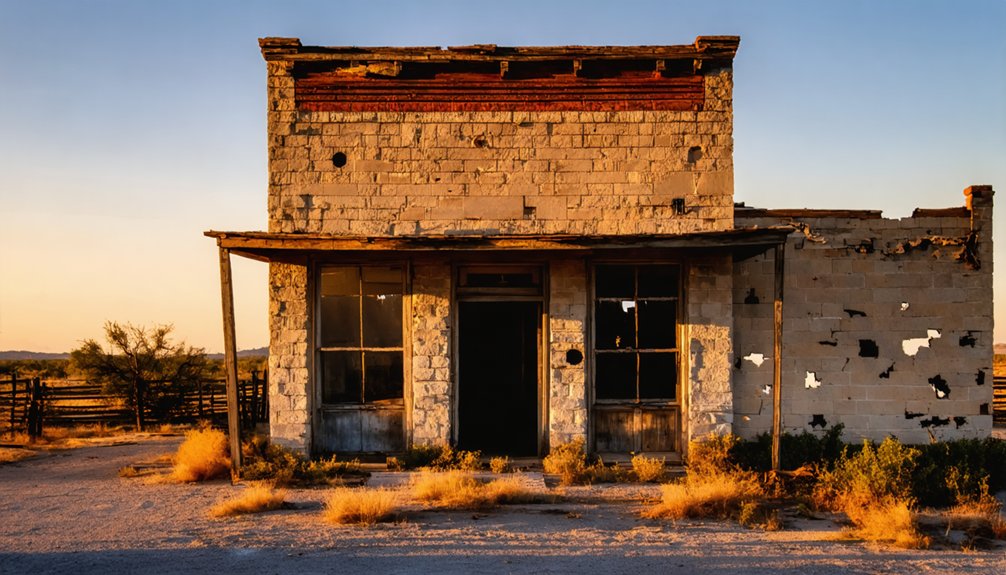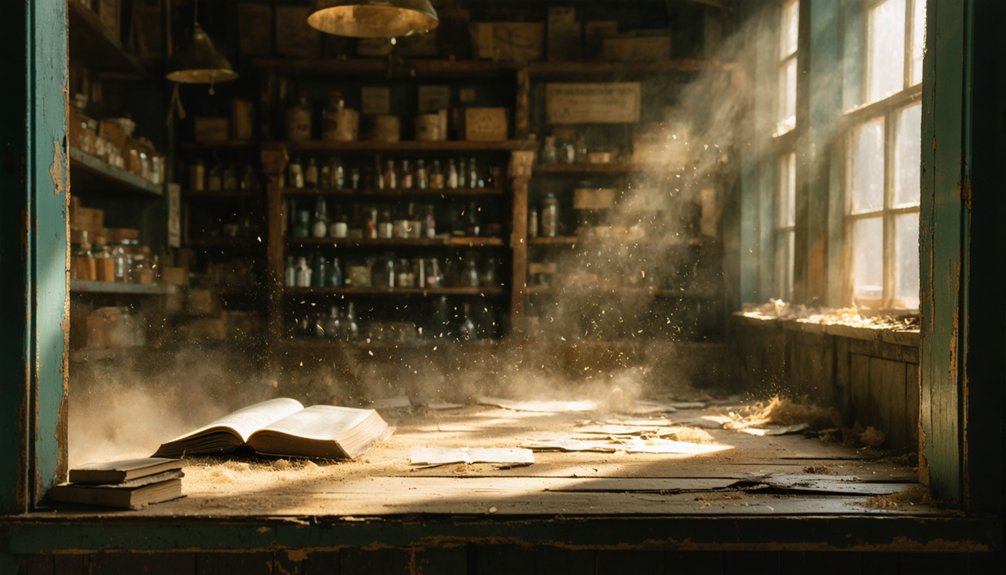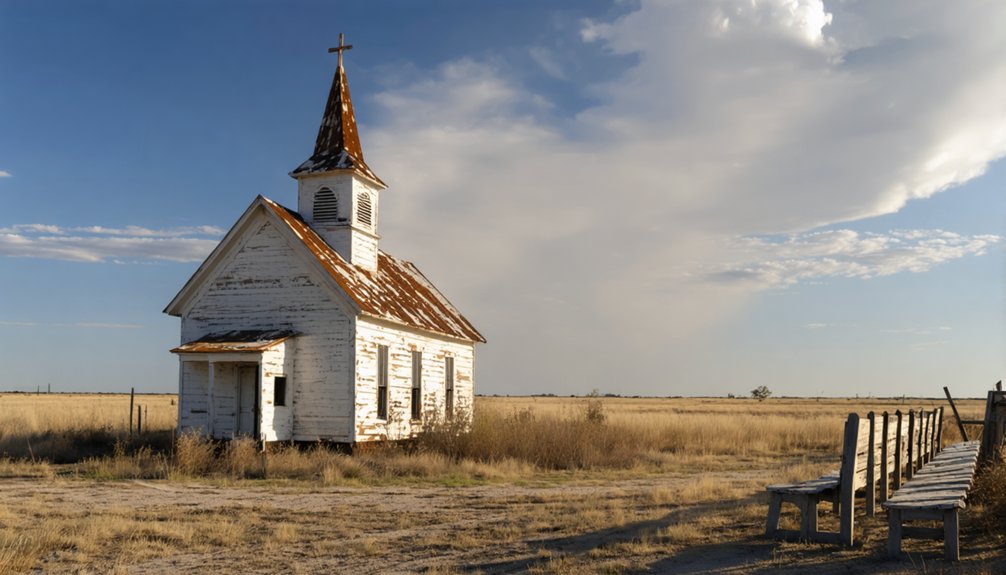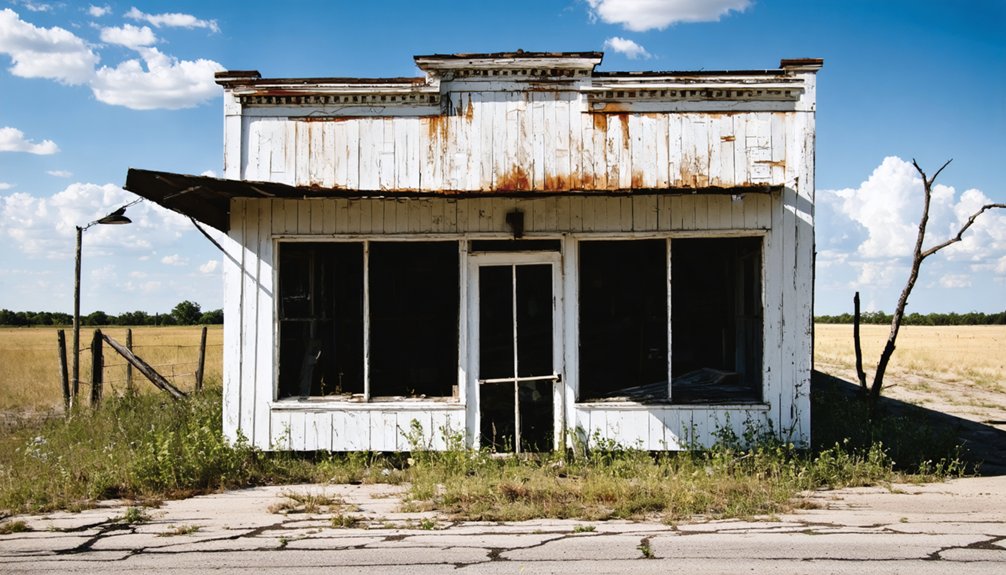You’ll find Loyal Valley ghost town in Mason County, Texas, where German settlers first established a thriving community in 1858. Originally called Cold Springs, it was renamed by John O. Meusebach during the Civil War. The town flourished with a hotel, saloon, and store along the historic Pinta Trail until the 1950s, when road rerouting led to its decline. Today, only the cemetery and scattered remnants mark this once-vibrant German settlement’s fascinating frontier story.
Key Takeaways
- Loyal Valley transformed from a thriving German settlement to a ghost town after the decline of stagecoach service in the 1950s.
- The town’s population diminished to approximately two dozen residents by the mid-1930s from its peak during the late 1800s.
- Today, only the Loyal Valley Cemetery and historical markers remain as physical evidence of the once-vibrant community.
- The town’s original structures, including its hotel, saloon, and general store, have largely disappeared from the landscape.
- Visitors can access the ghost town site via FM 2242 off US Highway 87, though few facilities remain for tourists.
The German Pioneer Settlement
While German immigration to Texas had already begun, it greatly accelerated in the 1840s through the efforts of the Adelsverein, a group of German nobles who established colonies like New Braunfels and Fredericksburg.
The Adelsverein, a society of German nobility, sparked a wave of immigration to Texas, founding settlements that preserved German culture.
As these colonies grew, German pioneer resilience led settlers to expand northward into Mason County, where they founded a settlement called Cold Springs in 1858. The settlers endured great hardships, including Indian raids and attacks that threatened their survival.
You’ll find that early settlers included the Keyser brothers and Mr. Gersdorff, who brought their European farming practices to the frontier.
John O. Meusebach, a prominent German immigrant leader, later renamed the settlement Loyal Valley to reflect his Union sympathies during the Civil War.
Under his leadership, the middle-class German immigrants established a thriving community with a church, school, stores, and stagecoach inn, while maintaining their strong Germanic language and customs. Like many settlers throughout the German Belt, they created a distinctive cultural enclave stretching from Galveston to Mason County.
Life Along the Pinta Trail
The Pinta Trail played a defining role in Loyal Valley’s development, carrying forward an ancient legacy that predated German settlement by centuries. Fort Martin Scott helped protect travelers using this vital route.
You’d find Indigenous pathways worn into the rugged Hill Country terrain, marking routes that connected essential water sources and settlements. The trail’s historical significance extended through Spanish colonial times, when it served as a critical military and supply route between San Antonio and frontier outposts. In 1854, Frederick Law Olmsted observed the once-vital pathway had fallen into disuse and become overgrown.
- Native Americans traversed the trail by foot and horse for hunting and trading
- Spanish and Mexican forces used it to access Presidio San Sabá
- German settlers adapted the trail for wagon transport to establish new communities
- The route influenced modern transportation corridors, including railways and highways
This ancient pathway shaped Loyal Valley’s location and growth, connecting your pioneering ancestors to broader networks of commerce and settlement.
A Thriving Frontier Community
During its 19th-century heyday, Loyal Valley emerged as a vibrant German settlement in southeastern Mason County, where John O. Meusebach established a general store and served multiple civic roles until 1897.
You’d have found a bustling community along the Pinta Trail, complete with a church, school, and Auguste Buchmeier’s inn serving stagecoach travelers between San Antonio and El Paso.
The town’s architecture reflected its German heritage, while cultural festivals celebrated the settlers’ traditions. The German immigrant landowners controlled much of the region’s prime agricultural property. You could watch the local baseball team play or visit any of several small stores. Residents enjoyed watching horse races on the adjoining prairie.
Cotton farming and cattle ranching drove the economy, making Loyal Valley a leading town in the Fisher-Miller Land Grant region.
Despite threats from Apache raids and tensions during the Mason County Hoo Doo War, the community maintained its distinctive German-American character.
Notable Figures and Leadership
You’ll find John O. Meusebach‘s influence woven throughout Loyal Valley‘s early development, as he established the town in 1869 and served multiple civic roles including postmaster and justice of the peace until his death in 1897.
The Buchmeier family made their mark through their prominent two-story inn, which became an essential stagecoach stop along the frontier route.
Auguste Buchmeier, who married into the family after losing her first husband Moritz Lehmann, exemplified the pioneer spirit by maintaining the inn’s operations while facing the harsh realities of frontier life, including the tragic Apache raids of 1870.
The area’s rich German heritage stems from the original settlers who arrived from Fredericksburg around 1858.
Meusebach’s dedication to the community was further demonstrated through his establishment of a store and nursery that helped sustain the growing settlement.
Meusebach’s Community Influence
After founding Fredericksburg, John O. Meusebach established himself as Loyal Valley’s cornerstone of leadership when he relocated there in 1869. His commitment to community trust and development shaped the town’s identity, starting with its very name – inspired by his unwavering loyalty to the Union during the Civil War. Like other company towns of the era that used armed guards, Meusebach maintained strict control over who entered the settlement. His renowned stone nursery buildings provided the town with agricultural innovations that helped sustain its growth.
- Served multiple civic roles including justice of the peace, postmaster, and notary public
- Designed and plotted the town’s layout to encourage organized settlement
- Opened a general store that became central to the local economy
- Maintained strong ties with German settlers while promoting Unionist values
You’ll find Meusebach’s influence extended beyond basic administration. He fostered a stable community during post-Civil War challenges, established essential infrastructure, and preserved German cultural heritage in the Texas Hill Country frontier until his death in 1897.
Buchmeier Family Pioneer Legacy
Among Loyal Valley’s pioneering families, the Buchmeiers established themselves as crucial community leaders when Philipp August Buchmeier and his wife Auguste settled there in the late 1860s.
Philipp’s stonemason craftsmanship and Auguste’s management of their two-story stagecoach inn contributed considerably to the town’s development.
The Buchmeier heritage faced a defining moment in 1870 when Apache raiders captured Auguste’s sons, Herman and Willie Lehmann.
While Willie escaped after nine days, Herman lived with Apache and Comanche tribes until 1878. This event demonstrated the community’s resilience during frontier challenges.
The family’s influence extended through their agricultural ventures in cotton and cattle, while their inn served as a crucial hub for travelers and locals alike.
Their legacy lives on in Mason County’s historical records and the local cemetery.
The Apache Raid of 1870

On May 16, 1870, a group of eight to ten Lipan Apache warriors raided Loyal Valley, capturing Herman Lehmann (age 10) and Willie Lehmann (age 8) from their family’s wheat fields while their sisters managed to escape.
Willie broke free after nine days, but Herman remained with the Apaches for eight years, becoming integrated into tribal life under his adoptive father Carnoviste before eventually reuniting with his family in 1878.
The raid marked a pivotal moment in Loyal Valley’s frontier history, heightening tensions between settlers and Native Americans while demonstrating the ongoing conflicts that characterized Texas settlement during this period.
The Buchmeier Children’s Capture
The dramatic capture of two young brothers, Herman and Willie Lehmann, occurred on May 16, 1870, when a band of eight to ten Lipan Apache warriors raided their family’s wheat field near Loyal Valley, Texas.
The Buchmeier children’s lives changed forever that day when Apache raiders seized the brothers while they were following their mother’s instructions to play in the field.
While their sisters managed to escape unharmed, the brothers faced different fates in captivity.
- Herman, age 11, remained with the Apaches for eight years, becoming assimilated into their culture.
- Willie, age 8, escaped after about two weeks during a cavalry pursuit.
Step-father Philip Buchmeier’s rescue attempt was delayed due to unavailable men.
Their mother Augusta never gave up hope, even seeking help from General Sherman.
Tribal Attack Details
Violence erupted in the wheat fields near Loyal Valley on May 16, 1870, when eight to ten Lipan Apache warriors descended upon the Buchmeier family property.
The raiders targeted four children working in the fields: Herman and Willie Lehmann, along with their two younger sisters. In a display of traditional Apache warfare, the warriors stripped the boys naked and tied them to separate horses.
You’d have witnessed the brutal efficiency of tribal diplomacy as the raiding party split up, each warrior taking a different route with their captive. While Willie escaped after a week, Herman remained in captivity.
One sister was shot and left for dead, though she survived. The other sister wasn’t taken during this swift and calculated attack that would forever change the region’s history.
Community Response Aftermath
Following the devastating Apache raid of 1870, residents of Loyal Valley united in an extraordinary eight-year quest to locate their missing community members, particularly young Herman Lehmann.
Community resilience shone through as Mrs. Buchmier traveled hundreds of miles, tirelessly seeking military aid to find her son.
The town’s emotional healing began in May 1878 when Lieutenant Colonel Davidson ordered Herman’s return under military escort.
- Herman’s sister identified him by a distinctive scar, helping bridge years of separation.
- Five soldiers and a driver transported Herman by mule-drawn ambulance to Mason County.
- The community gathered to witness his homecoming, marking a pivotal moment of reunion.
- You’ll find that despite Herman’s initial struggles with identity, townspeople supported his reintegration into settler life.
Economic Growth and Commerce

Located strategically along the Pinta Trail, Loyal Valley’s economic journey began in 1858 when German settlers from Fredericksburg established a thriving agricultural community.
You’d have found a bustling town center with a hotel, saloon, and store, serving both locals and travelers along the essential stagecoach route from San Antonio. Cotton farming and cattle ranching drove the local economy, supporting various trade networks and commercial enterprises.
However, you would’ve witnessed the town’s economic decline when the stagecoach service ended, followed by devastating commercial stagnation as major roads bypassed the settlement in the 1950s.
The end of stagecoach service and rerouting of major roadways sealed Loyal Valley’s fate, leaving the once-vibrant town frozen in time.
Without rail connections and cut off from main transportation routes, Loyal Valley couldn’t compete with Mason and Fredericksburg. By the mid-1930s, the once-prosperous community had dwindled to just two dozen residents.
Daily Life in Loyal Valley
During the 1870s, when Loyal Valley reached its peak population of 194 residents, daily life centered around a close-knit German immigrant community where you’d have found a vibrant mix of agricultural work and social activities.
Your daily routines would’ve revolved around farming cotton, tending cattle, and visiting Meusebach’s general store for supplies. Community celebrations often took place at the local church, where you’d gather with neighbors for religious services and social events.
The town’s baseball team provided entertainment, while the two-story inn and saloon served as meeting spots for both locals and travelers.
- You’d need to stay vigilant due to Apache raids threatening the area.
- Your children would attend the local school, where German traditions influenced education.
- You’d handle civic matters through John O. Meusebach, who served as postmaster and justice of peace.
- You’d find refuge in town during times of conflict, joining other outlying settlers.
The Path to Abandonment

Loyal Valley’s vibrant community life began to unravel in the late 19th century, sparked by a series of interconnected challenges.
You’d have witnessed the town’s strategic importance fade as railroads diverted traffic from the once-bustling Pinta Trail stagecoach route. The settlement patterns shifted dramatically after John O. Meusebach’s death in 1897, while ongoing Apache raids had already destabilized the community’s sense of security.
The town’s cultural heritage, deeply rooted in its German immigrant origins, couldn’t sustain itself as younger generations sought opportunities elsewhere. Agricultural hardships and limited infrastructure development pushed families toward more prosperous areas.
Modern-Day Ghost Town Legacy
While time has erased most physical traces of Loyal Valley’s pioneer settlement, you’ll find scattered remnants that tell the story of this once-thriving German community.
Today, the ghost town preservation efforts focus mainly on the Loyal Valley Cemetery, where historical markers commemorate the town’s fascinating past, including the tragic Buchmeier children’s story.
For historical tourism enthusiasts, the dramatic landscape of House Mountain and nearby Native American cave dwellings offer glimpses into the region’s rich heritage.
- Access the site via FM 2242 off US Highway 87, though you’ll find minimal visitor facilities
- Explore the cemetery’s historical markers that keep the town’s memory alive
- Visit nearby Fredericksburg for more developed German-Texan historical experiences
- Experience the authentic atmosphere of an untouched Texas ghost town, free from commercial development
Frequently Asked Questions
What Natural Resources and Minerals Were Found in the Loyal Valley Area?
Like a prospector’s dream, you’ll find limestone and granite formations through mineral exploration near you, plus deposits of manganese, tin, copper, and magnesite discovered during resource extraction in the area.
Were There Any Documented Murders or Shootouts in Loyal Valley’s History?
You won’t find documented murder mysteries or historical shootouts in surviving records. The only confirmed violence involved Apache raids, including the 1870 attack on the Buchmeier children.
What Happened to the Buchmeier Children After Their Capture?
Willie Buchmeier was rescued within nine days, while Herman lived among Apaches and Comanches for eight years before returning home. Their fate shaped their legacy – Herman wrote about his experiences.
Did Any Famous Outlaws or Historical Figures Visit Loyal Valley?
While you won’t find records of famous outlaws visiting, you’ll recognize John O. Meusebach as the most notable historical visitor. He founded the town in 1869 and lived there until his death in 1897.
What Crops Besides Cotton Were Commonly Grown by Loyal Valley Farmers?
While over 70% of farmers diversified beyond cotton, you’d find them growing apples, cherries, and figs in their orchards, alongside substantial sorghum production and wheat farming for both food and livestock.
References
- https://texashillcountry.com/loyal-valley-hill-country-ghost-town/
- https://www.historynet.com/ghost-town-loyal-valley-texas/
- https://texastimetravel.com/directory/loyal-valley-community-tour/
- https://www.lonestartreasure.com/texas-ghost-towns-and-their-buried-riches/
- https://freepages.history.rootsweb.com/~gtusa/usa/tx.htm
- https://www.ghosttowns.com/states/tx/loyalvalley.html
- https://www.historynet.com/tag/ghost-towns/page/6/
- https://www.texasescapes.com/TexasHillCountryTowns/Loyal-Valley-Texas.htm
- https://www.tshaonline.org/handbook/entries/loyal-valley-tx
- https://www.tshaonline.org/handbook/entries/germans



